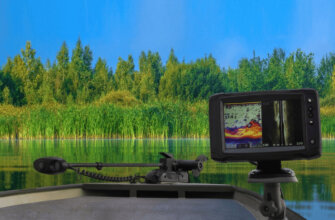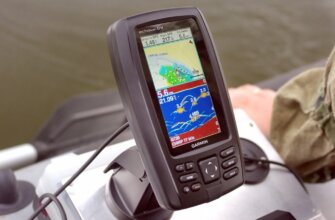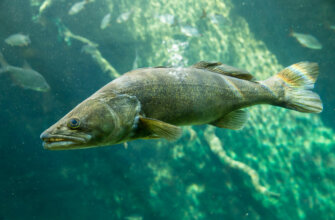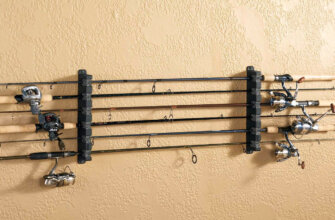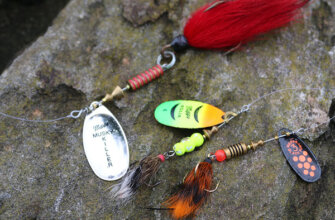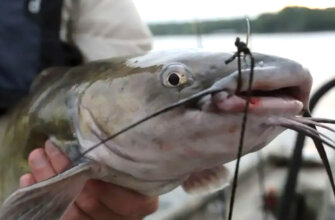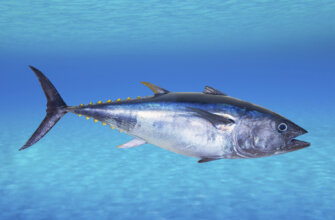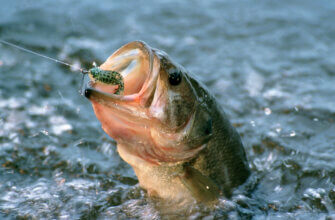A castable fish finder is a portable device that allows anglers to locate fish in bodies of water such as lakes, rivers, or oceans. It is designed to be cast from the shore or a boat and provides information about the underwater environment, including the depth, presence of fish, and underwater structures.
Here are some details about castable fish finders:
- Function: A castable fish finder uses sonar technology to transmit and receive sound waves in the water. It detects underwater objects, including fish, and displays the information on a compatible device like a smartphone or tablet.
- Casting: The device is compact and lightweight, allowing you to attach it to your fishing line and cast it into the water. It typically has a streamlined shape and a durable construction to withstand the impact of casting and landing.
- Sonar Technology: Castable fish finders use either traditional sonar or more advanced technologies like CHIRP (Compressed High-Intensity Radar Pulse) or DownScan Imaging. Traditional sonar emits a single frequency sound wave, while CHIRP uses a range of frequencies for better target separation and clarity. DownScan Imaging provides detailed, photo-like images of the underwater structure.
- Mobile Device Integration: Castable fish finders connect to your smartphone or tablet via Wi-Fi or Bluetooth. You’ll need to download a compatible mobile app that pairs with the device. The app displays the sonar readings, fish location, depth, and other relevant information in real-time.
- Depth Range: The depth range of castable fish finders varies depending on the model. Some can detect depths of up to 150 feet (45 meters) or more. It’s essential to consider the fishing conditions and choose a fish finder with an appropriate depth range for your needs.
- Mapping and GPS: Some castable fish finders have built-in GPS functionality, enabling you to create maps of fishing spots, mark waypoints, and track your location. These features can help you navigate and revisit productive areas in the future.
- Battery Life: Castable fish finders are powered by rechargeable batteries. Battery life varies depending on the model and usage but can range from a few hours to several days. It’s advisable to carry extra batteries or a portable charger for longer fishing trips.
- Data Interpretation: The mobile app associated with the castable fish finder provides a visual representation of the sonar readings. It displays fish icons or arches, water temperature, depth contours, and other relevant information. Learning to interpret the data can enhance your fishing experience and improve your chances of catching fish.
Castable fish finders are popular among anglers who fish from shore, kayak, canoe, or small boats. They offer a convenient and cost-effective way to access fish-finding technology without the need for a dedicated fish finder unit mounted on a boat.
10 best castable fish finder
While the “best” castable fish finder may vary depending on individual preferences and specific fishing needs, here are 10 popular castable fish finders known for their features and performance:
- Deeper PRO+ Smart Sonar: Offers dual beam sonar, GPS mapping, and detailed scanning. It has a casting range of up to 330 feet (100 meters) and a depth range of 260 feet (80 meters).
- Garmin Striker Cast: Provides clear scanning sonar, waypoint marking, and built-in GPS. It offers a casting range of up to 200 feet (61 meters) and a depth range of 150 feet (46 meters).
- FishHunter Directional 3D: Features 5 transducers for advanced 3D scanning, GPS mapping, and Wi-Fi connectivity. It has a casting range of up to 150 feet (46 meters) and a depth range of 160 feet (49 meters).
- iBobber Wireless Smart Fish Finder: Offers Bluetooth connectivity, fish and strike alarms, and GPS tagging. It has a casting range of up to 100 feet (30 meters) and a depth range of 135 feet (41 meters).
- Humminbird SmartCast RF35: Provides reliable sonar performance, fish and depth alarms, and audible alerts. It has a casting range of up to 120 feet (37 meters) and a depth range of 120 feet (37 meters).
- Vexilar SonarPhone T-Box: Features Wi-Fi connectivity, compatible with iOS and Android devices, and offers a variety of sonar views. It has a casting range of up to 240 feet (73 meters) and a depth range of 240 feet (73 meters).
- Lowrance FishHunter Pro: Offers Wi-Fi connectivity, 3D mapping, and advanced sonar features. It has a casting range of up to 150 feet (46 meters) and a depth range of 160 feet (49 meters).
- Lucky Wireless Fish Finder: Provides wireless sonar connectivity, fish alarm, and sensitivity adjustment. It has a casting range of up to 147 feet (45 meters) and a depth range of 131 feet (40 meters).
- ReelSonar iBobber Pulse: Offers Bluetooth connectivity, fish tagging, and trip logging. It has a casting range of up to 100 feet (30 meters) and a depth range of 135 feet (41 meters).
- HawkEye FishTrax 1C: Features portable design, audible fish alarm, and easy-to-read display. It has a casting range of up to 150 feet (46 meters) and a depth range of 240 feet (73 meters).
Remember to consider factors such as casting range, depth range, connectivity options, and additional features when selecting the right castable fish finder for your fishing needs.
Deeper PRO+ Smart Sonar

The Deeper PRO+ Smart Sonar is a portable wireless fish finder that provides detailed information about underwater structures, fish locations, and water conditions. It is designed for anglers who want to enhance their fishing experience by gaining better insights into the underwater environment.
Here are some key details about the Deeper PRO+ Smart Sonar:
- Sonar Technology: The PRO+ Smart Sonar uses advanced dual-beam sonar technology to provide accurate and detailed information about the underwater world. It utilizes both a narrow beam (15 degrees) for detailed scanning and a wide beam (55 degrees) for broader coverage.
- Wireless Connectivity: The device connects wirelessly to your smartphone or tablet via a Bluetooth connection. You can download the free Deeper app (available for iOS and Android) to view and analyze the sonar data in real-time.
- Depth Range: The PRO+ Smart Sonar has a maximum depth range of 260 feet (80 meters) and can scan underwater structures and fish at various depths. The depth is displayed on the app’s interface, allowing you to gauge the location of fish and other objects accurately.
- Mapping and GPS: The device includes built-in GPS functionality, allowing you to create bathymetric maps of the water bodies you fish in. You can mark your favorite fishing spots, record waypoints, and analyze the maps for future reference.
- Data Display: The Deeper app provides a user-friendly interface where you can view sonar data in different formats, such as traditional 2D sonar, fish icons, and raw data. It also displays information about water temperature, bottom contour, fish depth, and more.
- Fishing Features: The PRO+ Smart Sonar offers additional features to enhance your fishing experience. These include Fish Deeper, which helps you identify fish targets and provides fish size and depth indicators, as well as Ice Fishing Mode, which optimizes the sonar settings for ice fishing conditions.
- Durability and Battery Life: The device is designed to be durable and water-resistant. It has a rechargeable battery that provides approximately 5.5 hours of continuous usage, depending on various factors such as sonar settings and usage conditions.
| Advantages | Disadvantages |
| Portability: The Deeper PRO+ Smart Sonar is compact and lightweight, making it easy to carry and use in different fishing locations. It can be used from the shore, docks, kayaks, boats, or even ice fishing. Wireless Connectivity: The sonar device connects to your smartphone or tablet via Wi-Fi, eliminating the need for any additional screens or cables. You can view the sonar readings in real-time on your mobile device. Detailed Sonar Readings: The PRO+ Smart Sonar offers precise information about the underwater environment, including water depth, bottom contour, vegetation, fish location, and structure. It uses a dual-beam sonar system (290 kHz and 90 kHz) to provide accurate and comprehensive data. GPS Mapping: The device has built-in GPS functionality, allowing you to create detailed maps of the water bodies you’re exploring. You can mark and save your favorite fishing spots, analyze the terrain, and plan your fishing strategy accordingly. Versatility: The Deeper PRO+ Smart Sonar can be used in various fishing scenarios, including freshwater and saltwater fishing. It is suitable for different fishing techniques, such as casting, trolling, or vertical jigging. | Mobile Device Dependency: The PRO+ Smart Sonar relies on a smartphone or tablet for display and controls. This means you need to have a compatible device and keep it connected throughout your fishing session, which can drain the battery and limit other phone functionalities. Connectivity Range: The device operates using Wi-Fi connectivity, and its range can be affected by obstacles and interference. The connection range may vary depending on the device and environmental conditions, potentially limiting its effectiveness in certain situations. Limited Depth Range: While the Deeper PRO+ Smart Sonar is suitable for most fishing scenarios, it has a limited depth range compared to more advanced, dedicated fish finders. It is designed for depths up to 260 feet (79 meters), which may not be sufficient for deep-sea or offshore fishing. Sonar Cone Angle: The sonar cone angle of the PRO+ Smart Sonar is fixed at 15 degrees. While this provides a reasonable coverage area, it may not be ideal for capturing a wide range of underwater information in a single sweep. App Reliance: The device relies heavily on the companion mobile application for its functionality. If the app becomes outdated or incompatible with future operating systems, it may limit the long-term usability of the sonar device. |
Garmin Striker Cast

The Garmin Striker Cast is a fishing sonar device designed to help anglers enhance their fishing experience. It is a compact and portable fishfinder that pairs with your smartphone or tablet, allowing you to access fish-finding capabilities using the Garmin app.
Here are some key details about the Garmin Striker Cast:
- Sonar Technology: The device uses traditional sonar technology to provide clear and detailed images of fish and underwater structures. It utilizes CHIRP sonar, which sends a continuous range of frequencies to provide a more detailed view of the underwater environment.
- Wireless Connectivity: The Garmin Striker Cast connects to your smartphone or tablet using Bluetooth technology. You can download the Garmin app (compatible with iOS and Android) and wirelessly stream the sonar data to your mobile device.
- Casting Range: The device has a casting range of up to 60 meters (200 feet), allowing you to cover a significant area and find fish hotspots. It is suitable for various fishing styles, including shore fishing, kayak fishing, and ice fishing.
- GPS Location Tagging: With built-in GPS functionality, the Garmin Striker Cast allows you to mark and save waypoints, so you can easily navigate back to productive fishing spots in the future.
- Portable and Rechargeable: The Garmin Striker Cast is designed to be highly portable and easy to use. It is small in size and can be easily carried in your pocket or tackle box. The device comes with a rechargeable battery that provides several hours of continuous use on a single charge.
- Garmin Quickdraw Contours: When used in conjunction with the Garmin app, the Striker Cast supports Garmin Quickdraw Contours. This feature enables you to create personalized fishing maps with 1-foot contours, providing detailed information about underwater structures and contours in your favorite fishing spots.
- Compatibility: The Garmin Striker Cast is compatible with both freshwater and saltwater fishing. It can be used in various fishing environments, including lakes, rivers, streams, and coastal areas.
| Advantages | Disadvantages |
| Wireless Connectivity: The Garmin Striker Cast connects to your smartphone or tablet via Wi-Fi, allowing you to view fish and underwater structure details on your mobile device in real-time. It eliminates the need for additional screens or cables, making it a portable and convenient solution. Portable and Compact Design: The Striker Cast is small and lightweight, making it easy to carry and use in different fishing scenarios. It can be casted from shore, docks, or used with various fishing techniques like trolling or ice fishing. Detailed Sonar Readings: The device uses CHIRP sonar technology, which provides more detailed and accurate fish and structure detection compared to traditional sonar. It allows you to see fish arches, underwater contours, and vegetation, helping you locate and target fish effectively. Mobile App Features: The Garmin Fish & Hunt app, which is used in conjunction with the Striker Cast, offers additional features such as waypoint marking, trip logging, and social sharing. It allows you to save and revisit your favorite fishing spots, track your catches, and share your fishing adventures with others. Versatility: The Garmin Striker Cast is suitable for both freshwater and saltwater fishing. It can be used in various fishing environments, including lakes, rivers, and coastal areas. | Mobile Device Dependency: Similar to other smartphone-dependent fish finders, the Garmin Striker Cast requires a compatible smartphone or tablet for display and controls. This means you need to have your mobile device with you and keep it connected throughout your fishing session, which may drain the battery and limit other phone functionalities. Connectivity Range: The device operates using Wi-Fi connectivity, and its range can be affected by obstacles and interference. The connection range may vary depending on the device and environmental conditions, potentially limiting its effectiveness in certain fishing scenarios. Limited Depth Range: The Striker Cast has a maximum depth range of 150 feet (45 meters), which may not be sufficient for deep-sea or offshore fishing. It is more suitable for shallow to moderate depth fishing. Sonar Cone Angle: The device provides a relatively narrow sonar cone angle, which may limit the coverage area and require more casts or passes to thoroughly scan an area. App Reliance: The functionality and compatibility of the Garmin Fish & Hunt app are crucial for the overall performance of the Striker Cast. If the app becomes outdated or incompatible with future operating systems, it may affect the long-term usability of the fish finder. |
FishHunter Directional 3D
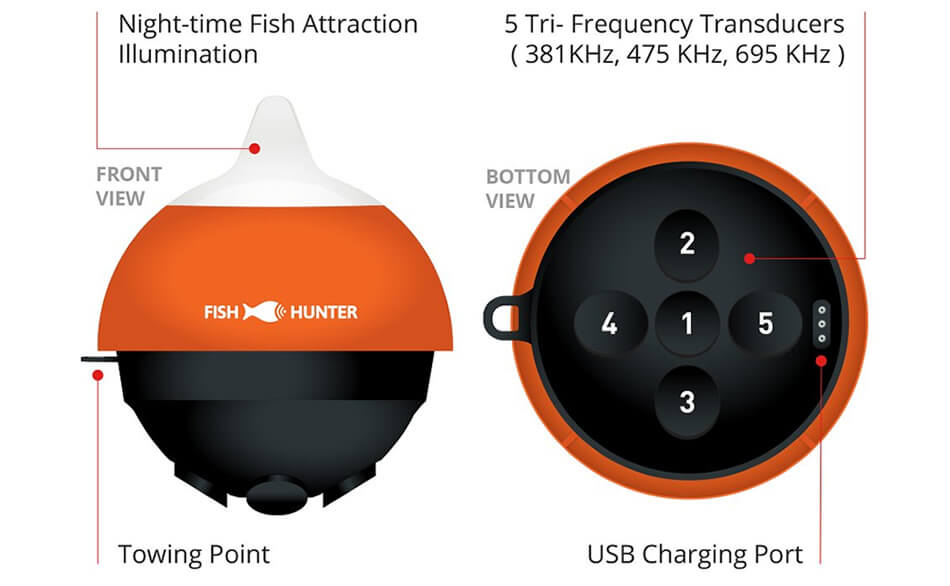
FishHunter Directional 3D is a portable fish finder device that utilizes sonar technology to help anglers locate fish underwater. It is designed to be compact, wireless, and easy to use, making it convenient for fishing enthusiasts of all levels.
The key feature of FishHunter Directional 3D is its ability to provide three-dimensional views of the underwater environment. Unlike traditional fish finders that only offer a two-dimensional representation, the FishHunter Directional 3D gives users a more comprehensive understanding of what is happening beneath the water’s surface.
Here are some notable features of the FishHunter Directional 3D:
- Directional Casting: The device can be cast out into the water using a fishing rod and line, allowing you to explore different areas. It has an impressive casting range of up to 150 feet (45 meters).
- Tri-Frequency Coverage: FishHunter Directional 3D operates using three different frequencies (381 kHz, 475 kHz, and 675 kHz). This tri-frequency coverage enhances its ability to detect fish and underwater structures accurately.
- Three-Dimensional Mapping: Once the device is in the water, it sends sonar signals and creates a detailed three-dimensional map of the underwater terrain. Users can view this map in real-time on their smartphones or tablets via the FishHunter app.
- Fish Identification and Depth Detection: The FishHunter Directional 3D can identify fish targets and display their depths on the app. This information helps anglers determine the best spots to target specific species.
- Bathymetric Mapping: In addition to real-time mapping, the device also allows users to create bathymetric maps of water bodies. These maps provide information on the contours and depths of the lake, river, or other waterways.
- Offline Mapping: The FishHunter app allows you to save maps and use them offline, ensuring that you can access your fishing spots even without an internet connection.
- Integrated LED Light: The FishHunter Directional 3D features a built-in LED light that assists with nighttime fishing or low-light conditions. It improves visibility and makes it easier to locate the device in the water.
- Portable and Durable: The device is designed to be compact and rugged, making it suitable for various fishing environments. It is also waterproof and capable of withstanding immersion in water.
| Advantages | Disadvantages |
| Three-Dimensional Imaging: The FishHunter Directional 3D offers advanced sonar imaging capabilities, providing anglers with a three-dimensional view of the underwater environment. This allows for better visualization of fish, structures, and contours, making it easier to identify fish-holding areas. Multiple Sonar Views: The device provides multiple sonar views, including 3D Fishing, Directional Casting, and Ice Fishing Flasher modes. Each mode offers unique features and displays, catering to different fishing scenarios and techniques. Wireless and Portable: The FishHunter Directional 3D is wireless and portable, allowing for easy use in various fishing situations. It can be casted from shore, attached to boats or kayaks, and used for ice fishing. The compact design makes it convenient to carry and transport. Long Distance Casting: The fish finder has a long casting range, enabling anglers to cover larger areas and reach fish-holding spots that are farther away. This can be particularly useful when fishing from the shore or from a distance. Fish Alarm and GPS Tagging: The device includes a fish alarm feature that notifies you when fish are detected. It also has a built-in GPS, allowing you to mark and save fishing spots, record tracks, and navigate back to specific locations. | Battery Life: The FishHunter Directional 3D operates on a built-in rechargeable battery. However, the battery life can be limited, especially when using the device for extended periods or in challenging weather conditions. It’s important to manage power usage and carry backup power solutions if necessary. Mobile Device Dependency: The fish finder relies on a compatible smartphone or tablet for display and control. While this allows for a larger screen and access to additional features, it also means that you need to have a device with you and maintain a wireless connection, potentially draining the battery and limiting phone functionality. Learning Curve: The advanced features and multiple sonar views of the FishHunter Directional 3D may have a learning curve. It can take some time and practice to fully understand and utilize the different imaging modes and interpret the sonar readings effectively. Connectivity Range: The wireless range of the FishHunter Directional 3D can be affected by environmental factors, such as obstacles and interference. The connection range may vary, and it’s important to ensure a stable and reliable connection between the fish finder and your mobile device. Limited Depth Range: The fish finder has a maximum depth range of around 160 feet (49 meters). While this is sufficient for most freshwater fishing scenarios, it may not be suitable for deep-sea or offshore fishing, where greater depth capabilities are required. |
iBobber Wireless Smart Fish Finder

The iBobber Wireless Smart Fish Finder is a portable fish finder device that connects to your smartphone or tablet via Bluetooth technology. It is designed to help anglers locate and catch fish more effectively by providing them with real-time sonar information.
Here are some key features of the iBobber Wireless Smart Fish Finder:
- Sonar Technology: The iBobber uses sonar technology to detect fish, underwater structures, and the depth of the water. It sends the sonar signals and receives the information back to provide a visual representation of the underwater environment.
- Wireless Connectivity: The device connects to your smartphone or tablet using Bluetooth, allowing you to view the sonar readings directly on your device’s screen. The wireless connection has a range of up to 100 feet (30 meters), providing flexibility in fishing locations.
- Fish Identification and Depth Detection: The iBobber can identify fish targets and display their depths on your smartphone or tablet. This information helps you determine the optimal fishing spots and depths for specific species.
- GPS Tagging and Mapping: The iBobber allows you to mark your favorite fishing spots using GPS tagging. You can also create custom maps and mark waypoints to track your fishing activities.
- Fish Alarm and Strike Alarm: The device has customizable fish and strike alarms. When a fish is detected or when there is a strike on your line, the iBobber will alert you with an audible alarm on your smartphone or tablet.
- Weather and Water Conditions: The iBobber app provides real-time weather forecasts and water conditions, including temperature and clarity. This information helps you make informed decisions about your fishing trips.
- Lunar Calendar and Solunar Times: The iBobber app includes a lunar calendar and solunar times, which can be helpful in predicting fish feeding patterns and activity levels based on lunar phases.
- Battery Life and Charging: The iBobber has a rechargeable battery that lasts for several hours of continuous use. It can be charged using a USB cable, making it easy to recharge the device when needed.
| Advantages | Disadvantages |
| Portability: The iBobber is small, lightweight, and designed to be easily carried in a tackle box or pocket. It can be used for various fishing scenarios, including shore fishing, kayak fishing, and ice fishing. Wireless Connectivity: The fish finder connects to your smartphone or tablet via Bluetooth, allowing you to view sonar readings directly on your mobile device. It eliminates the need for additional screens and cables. Sonar Technology: The iBobber uses sonar to provide information about water depth, bottom contour, and the presence of fish. It has a depth capability of up to 135 feet (41 meters), depending on the model. GPS Tagging: The device includes GPS functionality that enables you to mark and save fishing spots. You can revisit these spots later and use the GPS feature for navigation purposes. Fish Alarm and LED Beacon: The iBobber has a fish alarm feature that alerts you when fish are detected. It also has an LED beacon that can be customized to flash different colors, providing additional visual cues when fishing at night or in low-light conditions. | Smartphone Dependency: The iBobber relies on a compatible smartphone or tablet for display and controls. This means you need to have your mobile device with you and maintain a Bluetooth connection, which may drain the battery and limit other phone functionalities. Limited Connectivity Range: Bluetooth connectivity has a limited range, typically around 100 feet (30 meters). If you move too far away from the iBobber, the connection between the fish finder and your smartphone may be lost. Limited Depth Range: While the iBobber is suitable for most fishing scenarios, its depth range of up to 135 feet (41 meters) may not be sufficient for deep-sea or offshore fishing, where greater depth capabilities are required. Sonar Cone Angle: The iBobber has a relatively narrow sonar cone angle, which may limit the coverage area and require multiple casts or passes to fully scan an area. App Reliance: The functionality and compatibility of the iBobber app are crucial for the overall performance of the fish finder. If the app becomes outdated or incompatible with future operating systems, it may affect the long-term usability of the device. |
Humminbird SmartCast RF35

The Humminbird Smartcast RF35 is a discontinued fishfinder product from Humminbird. It was part of the Smartcast series, which was designed to be a portable and wireless fishfinder system.
The RF35 fishfinder unit featured a remote sonar sensor that could be cast into the water, allowing you to scan for fish and underwater structures. The sensor used radio frequency (RF) technology to transmit sonar readings back to the main display unit, which was typically worn on your wrist like a watch.
The display unit of the RF35 showed various information such as water depth, water temperature, fish location, and underwater terrain. It had a small screen and limited functionality compared to traditional fixed-mount fishfinders, but it provided a convenient and portable option for anglers who wanted to have basic fishfinding capabilities without the need for a boat or installation.
It’s worth noting that the Humminbird Smartcast RF35 is no longer being manufactured, and Humminbird has since released newer and more advanced fishfinder models. If you’re looking for a fishfinder system, I recommend checking out Humminbird’s current lineup or exploring other brands to find a fishfinder that suits your needs.
| Advantages | Disadvantages |
| Wrist-Mounted Display: The RF35 comes with a convenient wrist-mounted display, allowing you to have real-time sonar readings directly on your wrist. This frees up your hands and provides easy access to the information while fishing. Wireless Sonar Technology: The SmartCast RF35 utilizes wireless sonar technology, eliminating the need for cables and complicated setups. It wirelessly transmits sonar signals from the floating sonar sensor to the wrist-mounted display. Portable and Compact: The device is portable and compact, making it easy to carry and use in different fishing scenarios. It is suitable for shore fishing, kayak fishing, or any situation where portability is important. Depth and Fish Detection: The SmartCast RF35 provides information about water depth, underwater structure, and fish location. It allows you to locate fish-holding areas and adjust your fishing strategy accordingly. Versatility: The SmartCast RF35 is suitable for both freshwater and saltwater fishing. It can be used in various fishing environments, including lakes, rivers, and coastal areas. | Limited Display Size: The wrist-mounted display of the RF35 is relatively small compared to other fish finders with larger screens. This may make it slightly challenging to interpret the sonar readings, especially if you prefer a larger and more detailed display. Limited Range: The wireless range of the SmartCast RF35 may be limited compared to other fish finders that use different transmission methods. The effective range may vary depending on environmental conditions, such as obstacles and interference. Battery Life: The RF35 operates on batteries, and the battery life may be limited, especially with continuous use over long fishing sessions. It’s important to carry extra batteries or have a backup power solution available to ensure uninterrupted operation. Sonar Cone Angle: The device provides a relatively narrow sonar cone angle, which may limit the coverage area and require multiple casts or passes to fully scan an area. Data Interpretation: The sonar readings on the RF35 may require some experience and interpretation skills to understand and utilize effectively. It may take some time and practice to get accustomed to interpreting the sonar information accurately. |
Vexilar SonarPhone T-Box

The Vexilar SonarPhone T-Box is a fishfinder system that allows you to transform your smartphone or tablet into a fully functional sonar display. It is designed and manufactured by Vexilar, a company known for its high-quality fishing electronics.
The SonarPhone T-Box consists of a small, compact device that connects to your smartphone or tablet via Wi-Fi. Once connected, it enables you to view and control sonar data directly on your mobile device’s screen. The T-Box itself acts as a transducer, sending sonar signals into the water and receiving the echoes to create detailed images of the underwater environment.
Key features and capabilities of the SonarPhone T-Box include:
- Wi-Fi Connectivity: The T-Box connects to your mobile device using Wi-Fi, allowing you to wirelessly stream sonar data without the need for additional cables.
- Sonar Imaging: It provides real-time sonar imaging, displaying information such as water depth, temperature, and fish location. You can use different sonar views, including traditional 2D sonar and flasher modes.
- Mobile App: The T-Box requires a dedicated mobile app (available for iOS and Android) to interface with your smartphone or tablet. The app offers various settings and features to customize your sonar experience.
- Portable and Versatile: The compact size of the T-Box makes it easy to carry and use on different fishing vessels, such as boats, kayaks, or even ice fishing setups. It offers flexibility in terms of where and how you fish.
- Compatibility: The SonarPhone T-Box is compatible with a wide range of mobile devices, ensuring that most smartphones and tablets can be used as the display unit.
| Advantages | Disadvantages |
| Wireless Connectivity: The SonarPhone T-Box connects wirelessly to your smartphone or tablet via Wi-Fi, allowing you to view sonar readings directly on your mobile device. It eliminates the need for additional screens or cables. Portable and Versatile: The T-Box is compact and easy to carry, making it suitable for various fishing scenarios. It can be used from shore, docks, kayaks, or boats, and it is compatible with both freshwater and saltwater fishing. Multiple Sonar Views: The SonarPhone app provides multiple sonar views, including traditional 2D, flasher mode, and split-screen display options. This allows you to customize the sonar view to your preference and fishing style. Detailed Sonar Readings: The T-Box provides detailed sonar information, including water depth, bottom contour, and fish location. It uses a high-frequency transducer to deliver accurate and comprehensive data. GPS Mapping and Navigation: The SonarPhone app offers GPS mapping functionality, allowing you to mark waypoints, create custom maps, and navigate to specific locations. This feature can be beneficial for tracking productive fishing spots and planning future trips. | Mobile Device Dependency: The T-Box relies on a compatible smartphone or tablet for display and controls. This means you need to have your mobile device with you and maintain a Wi-Fi connection throughout your fishing session, which may drain the battery and limit other phone functionalities. Connectivity Range: The range of the SonarPhone T-Box’s Wi-Fi connection may be affected by environmental factors, such as obstacles and interference. The connection range can vary, potentially limiting its effectiveness in certain fishing scenarios. App Reliance: The functionality and compatibility of the SonarPhone app are essential for the overall performance of the T-Box. If the app becomes outdated or incompatible with future operating systems, it may affect the long-term usability of the fish finder. Battery Life: The T-Box operates on a built-in rechargeable battery. However, the battery life may be limited, especially with extended use or in challenging weather conditions. It’s important to manage power usage and carry backup power solutions if necessary. Learning Curve: The SonarPhone app and the T-Box system may have a learning curve, especially for users who are new to fish finders or smartphone-based technology. It may take some time and practice to fully understand and utilize all the features and settings. |
Lowrance FishHunter Pro
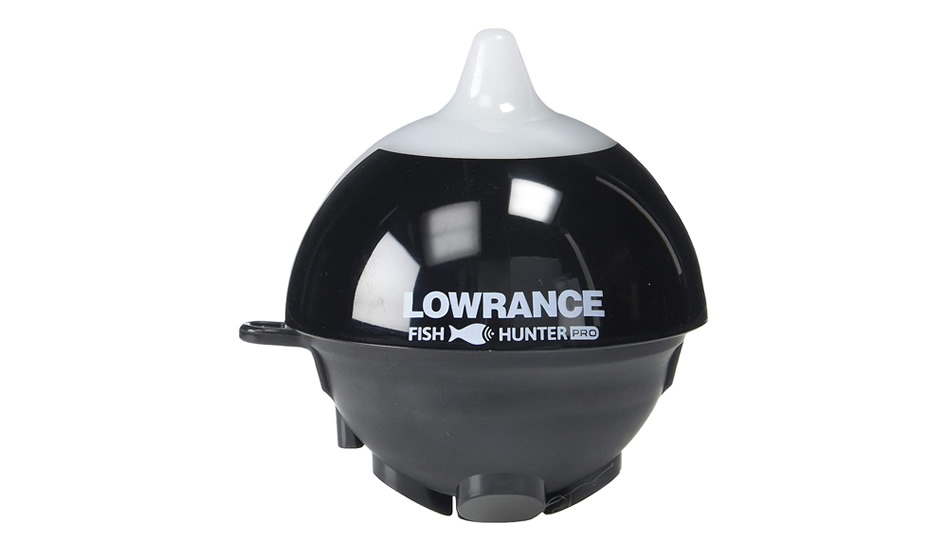
The Lowrance FishHunter Pro is a portable fishfinder designed for anglers who want to use their mobile devices as a display unit. It is manufactured by Lowrance, a well-known company in the marine electronics industry.
The FishHunter Pro is a compact, wireless fishfinder that uses a transducer to send sonar signals into the water and receive the echoes. It connects to your smartphone or tablet via Wi-Fi, allowing you to view and interpret the sonar data on your mobile device’s screen.
Key features and capabilities of the Lowrance FishHunter Pro include:
- Wireless Connectivity: The FishHunter Pro utilizes Wi-Fi technology to connect with your mobile device, eliminating the need for additional cables. This wireless connection allows you to have a clutter-free and convenient fishing experience.
- Sonar Imaging: It provides real-time sonar imaging, displaying information such as water depth, bottom contour, fish location, and structure. You can choose from different sonar views, including traditional 2D sonar, 3D sonar, and fish view modes.
- Mobile App: The FishHunter Pro requires a dedicated mobile app (available for iOS and Android) to interface with your smartphone or tablet. The app offers a user-friendly interface and various settings to customize your sonar experience.
- Portable and Versatile: The compact design of the FishHunter Pro makes it easy to carry and use in different fishing scenarios. It can be cast from shore, mounted on a boat, or used for ice fishing. It is also waterproof and durable.
- GPS Integration: Some versions of the FishHunter Pro come with built-in GPS capabilities, allowing you to mark waypoints, track your position, and map your fishing spots.
| Advantages | Disadvantages |
| Portable and Wireless: The FishHunter Pro is compact and lightweight, making it highly portable and easy to carry. It is designed for use in various fishing scenarios, including shore fishing, kayak fishing, and ice fishing. It operates wirelessly, eliminating the need for cables and complicated setups. Wireless Connectivity: The fish finder connects to your smartphone or tablet via Wi-Fi, allowing you to view sonar readings directly on your mobile device. This provides a convenient and familiar display for anglers, eliminating the need for additional screens. Sonar Technology: The FishHunter Pro uses sonar technology to provide detailed information about water depth, underwater structure, and the presence of fish. It offers multiple sonar views, including 3D maps, raw sonar, and fish view modes, allowing you to customize your display and adapt to different fishing scenarios. Mapping and GPS Features: The FishHunter Pro app includes mapping and GPS functionalities, allowing you to mark and save fishing spots, create custom maps, and navigate back to specific locations. These features can be useful for tracking productive fishing areas and planning future trips. Versatility: The FishHunter Pro is suitable for both freshwater and saltwater fishing. It can be used in various fishing environments, including lakes, rivers, and coastal areas. | Mobile Device Dependency: The FishHunter Pro relies on a compatible smartphone or tablet for display and controls. This means you need to have your mobile device with you and maintain a Wi-Fi connection, which may drain the battery and limit other phone functionalities. Connectivity Range: The wireless range of the FishHunter Pro may be limited compared to other fish finders that use different transmission methods. The effective range may vary depending on environmental conditions, such as obstacles and interference. Battery Life: The FishHunter Pro operates on a built-in rechargeable battery. However, the battery life may be limited, especially with continuous use over extended fishing sessions. It’s important to manage power usage and carry backup power solutions if necessary. Sonar Cone Angle: The FishHunter Pro has a relatively narrow sonar cone angle, which may limit the coverage area and require multiple casts or passes to thoroughly scan an area. App Reliance: The functionality and compatibility of the FishHunter Pro app are crucial for the overall performance of the fish finder. If the app becomes outdated or incompatible with future operating systems, it may affect the long-term usability of the device. |
Lucky Wireless Fish Finder

The Lucky Wireless Fish Finder is a compact and wireless fishfinder system that helps anglers locate fish and underwater structures. While specific features and capabilities may vary depending on the model, here are some common characteristics associated with Lucky wireless fish finders:
- Wireless Connectivity: The Lucky fish finder uses wireless technology, typically operating on a sonar frequency, to transmit sonar readings from the transducer to the display unit. This eliminates the need for cables and offers greater flexibility in positioning the display unit.
- Transducer and Sonar: The fish finder typically comes with a transducer that emits sonar signals into the water and receives the echoes to generate images of the underwater environment. The sonar capabilities can include depth readings, fish location, bottom contour, and more, depending on the model.
- Portable and Compact: Lucky wireless fish finders are often designed to be small and portable, making them easy to carry and use in various fishing scenarios. They can be used for shore fishing, kayak fishing, or other situations where portability is important.
- Display Unit: The fish finder system includes a display unit that receives and shows the sonar data. The display unit can vary in size, resolution, and features depending on the specific model. Some models may have a built-in screen, while others may require connecting to a smartphone or tablet via Bluetooth or Wi-Fi.
- Battery Life and Waterproofing: Lucky wireless fish finders usually have a built-in rechargeable battery to power the system. The battery life can vary, so it’s essential to consider the expected usage time. Additionally, many models are designed to be waterproof or water-resistant to withstand the fishing environment.
| Advantages | Disadvantages |
| Portability: The Lucky Wireless Fish Finder is small, lightweight, and easy to carry. It is designed for use in various fishing scenarios, including shore fishing, kayak fishing, and ice fishing. Its compact size makes it convenient to bring along on fishing trips. Affordability: The Lucky Wireless Fish Finder is known for its affordability compared to other fish finders on the market. It offers a cost-effective solution for anglers who are on a budget or looking for an entry-level fish finder. Wireless Connectivity: The fish finder connects wirelessly to your smartphone or tablet via Wi-Fi or Bluetooth, allowing you to view sonar readings directly on your mobile device. This eliminates the need for additional screens or cables. Sonar Technology: The Lucky Wireless Fish Finder utilizes sonar technology to provide information about water depth, underwater structure, and the presence of fish. It offers real-time sonar readings, allowing you to adjust your fishing strategy accordingly. User-Friendly Interface: The fish finder typically comes with a user-friendly interface and intuitive controls, making it easy to operate and understand. It is suitable for anglers of all skill levels, including beginners. | Limited Range: The wireless range of the Lucky Wireless Fish Finder may be limited compared to other fish finders that use different transmission methods. The effective range may vary depending on environmental conditions, such as obstacles and interference. Battery Life: The Lucky Wireless Fish Finder operates on a built-in rechargeable battery. However, the battery life may be limited, especially with continuous use over extended fishing sessions. It’s important to manage power usage and carry backup power solutions if necessary. Sonar Cone Angle: The fish finder may have a relatively narrow sonar cone angle, which can limit the coverage area and require multiple casts or passes to fully scan an area. App Reliance: The functionality and compatibility of the fish finder’s app are essential for the overall performance of the device. If the app becomes outdated or incompatible with future operating systems, it may affect the long-term usability of the fish finder. Limited Features and Customization: Compared to higher-end fish finders, the Lucky Wireless Fish Finder may have limited features and customization options. Advanced functions such as GPS mapping, multiple sonar views, and advanced data analysis may be lacking. |
ReelSonar iBobber Pulse

The iBobber Pulse is a fish finder product offered by ReelSonar. It is a compact and portable fish finder designed for recreational fishing.
Key features and capabilities of the iBobber Pulse ReelSonar fish finder include:
- Portable Design: The iBobber Pulse is small and lightweight, making it easy to carry and use in various fishing situations. It is designed to be castable and can be used from shore, on a boat, or even for ice fishing.
- Sonar Technology: The fish finder utilizes sonar technology to provide real-time information about the underwater environment. It can detect and display depth, water temperature, fish location, and structure.
- Mobile App Integration: The iBobber Pulse connects to your smartphone or tablet via Bluetooth and integrates with a dedicated mobile app (available for iOS and Android). The app serves as the display unit, showing the sonar readings and providing additional features such as fish alarms, GPS mapping, and logging.
- Fish Alarm and Mapping: The mobile app allows you to set fish alarms, so you’ll be notified when fish are detected. It also offers mapping functionalities, allowing you to mark waypoints and create detailed fishing maps of your favorite spots.
- Rechargeable Battery: The iBobber Pulse is equipped with a rechargeable battery that provides power for several hours of use. The battery can be charged using a USB cable, making it convenient for recharging on the go.
| Advantages | Disadvantages |
| Portability: The iBobber Pulse is a compact and lightweight device that can easily fit in your tackle box or pocket. Its small size makes it highly portable and convenient to carry around. Wireless Connectivity: The device connects to your smartphone or tablet via Bluetooth, allowing you to view fish activity and underwater structures on your mobile device. This wireless connection eliminates the need for additional cables and provides greater flexibility in accessing the data. Fish Finding Capabilities: The iBobber Pulse uses sonar technology to detect fish and underwater structures. It can accurately identify fish location, size, depth, and the bottom contour of the water body. This information helps anglers make informed decisions about where to cast their lines. Smart Mapping: The device comes with built-in GPS and mapping features, allowing you to create custom maps of your fishing spots. You can mark waypoints, record hotspots, and track your fishing path. These mapping capabilities help you revisit productive locations and improve your fishing strategy. User-Friendly Interface: The iBobber Pulse app provides a user-friendly interface with intuitive controls and clear visuals. It is easy to set up and navigate, making it suitable for anglers of all experience levels. | Limited Range: The iBobber Pulse operates within a limited range due to its Bluetooth connectivity. The range can vary depending on the environment, but typically it’s around 100 feet (30 meters). If you require a longer range, this device may not be suitable for your needs. Smartphone Dependency: The iBobber Pulse relies on a smartphone or tablet for displaying sonar readings and maps. While this allows for a more portable and streamlined setup, it also means you need to have a compatible device and the associated app installed to use the device effectively. Battery Life: The device has a built-in rechargeable battery that powers both the iBobber Pulse and its Bluetooth connection. The battery life may vary depending on usage, but it typically lasts around 10 hours. However, extensive use of the app and sonar features can drain the battery more quickly, requiring frequent recharging. Limited Depth Range: The iBobber Pulse is designed for shallow-water fishing and performs optimally in water depths up to 135 feet (41 meters). If you regularly fish in deep water bodies, you may find the depth range limitation of this device restrictive. Sonar Performance: While the iBobber Pulse provides fish-finding capabilities, the quality and accuracy of the sonar readings may not match those of more advanced and expensive fish finders. The device’s sonar performance can be affected by factors such as water conditions, vegetation, and underwater obstructions. |
HawkEye FishTrax 1C

The HawkEye FishTrax 1C is a fish finder manufactured by HawkEye Electronics. It is designed to provide anglers with portable and user-friendly fish-finding capabilities.
Here are some key features and information about the FishTrax 1C:
- Portable and Compact Design: The FishTrax 1C is a small and lightweight fish finder, making it highly portable. It is suitable for various fishing scenarios, including kayak fishing, ice fishing, and shore fishing.
- Display and Sonar Technology: The FishTrax 1C features a color LCD display that shows sonar readings and other information. It utilizes sonar technology to detect underwater objects, fish, and depth. The sonar beam angle is typically 14 degrees.
- Fish ID and Depth Range: The fish finder incorporates a Fish ID+ feature, which helps identify fish targets and displays them as fish icons on the screen. It also provides depth readings, allowing you to determine the water depth at a glance. The depth range can vary but is generally between 2.5 and 240 feet (0.8 to 73 meters).
- Dual-Frequency Sonar: The FishTrax 1C offers dual-frequency sonar capabilities, allowing you to switch between 200 kHz and 83 kHz frequencies. This flexibility enables you to adjust the sonar frequency based on your fishing conditions and preferences.
- Mounting Options and Power Source: The fish finder can be used in a variety of mounting configurations, such as handheld, pole-mounted, or with an optional transom-mount bracket (sold separately). The FishTrax 1C typically operates on replaceable AA batteries for power.
- Additional Features: The FishTrax 1C may include other features such as audible fish and depth alarms, backlighting for low-light conditions, and various user-adjustable settings for sensitivity, depth range, and more.
| Advantages | Disadvantages |
| Versatility: The FishTrax 1C is suitable for various fishing environments, including freshwater, saltwater, and ice fishing. It can be used in lakes, rivers, ponds, and even offshore fishing situations, providing versatility for different fishing scenarios. Depth Range: The FishTrax 1C has a maximum depth range of 240 feet (73 meters), allowing anglers to explore deeper waters. This makes it suitable for both shallow and moderately deep fishing locations. Multiple Frequencies: The device uses dual-frequency sonar technology, allowing you to choose between 83 kHz and 200 kHz frequencies. The lower frequency (83 kHz) is suitable for deeper water, while the higher frequency (200 kHz) provides better detail in shallower water. Fish and Structure Identification: The FishTrax 1C can display fish arches, which help identify the presence and location of fish. It also provides information about the underwater structure, such as contours, weeds, and drop-offs. This enables anglers to target specific areas where fish are likely to be located. User-Friendly Interface: The device features a clear and easy-to-read LCD screen with backlighting, making it convenient to use in various lighting conditions. The interface provides intuitive menu navigation and customizable settings for a personalized fishing experience. | Limited Screen Size: The FishTrax 1C has a compact screen size, which may limit the amount of information that can be displayed at once. This could make it challenging to view detailed sonar readings or maps, especially for users who prefer larger screens. No GPS or Mapping: Unlike some higher-end fish finders, the FishTrax 1C does not include built-in GPS or mapping capabilities. It does not offer features like waypoint marking or route tracking. If you rely heavily on GPS and mapping for your fishing, this device may not meet your needs. Transducer Mounting Options: The FishTrax 1C comes with a transducer that can be mounted on a boat or kayak, but it may not be as versatile for other mounting options. If you require alternative mounting methods, such as through-hull or portable transducer mounts, you may need additional accessories or consider a different fish finder. Sonar Performance: While the FishTrax 1C provides fish-finding capabilities, the sonar performance may not be as advanced or high-resolution compared to more expensive models. This could result in slightly less accurate readings or reduced detail in certain fishing scenarios. Battery Life: The device operates on AA batteries, which may have a shorter lifespan compared to rechargeable batteries found in other fish finders. Depending on usage, you may need to carry spare batteries or consider investing in rechargeable batteries to ensure uninterrupted fishing sessions. |

